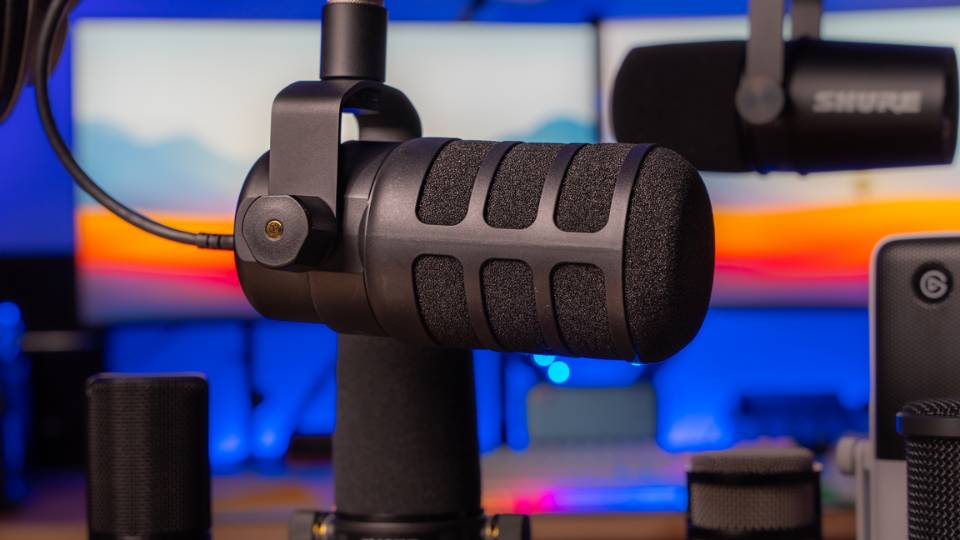Links in this post may be affiliate links. Any products purchased through affiliate links may provide a small commission which helps to support the SemiPro Tech+Gear site and YouTube channel.
A few weeks ago I provided my initial take on the Rode PodMic USB, the newest microphone offering from Rode. I’ve been testing it for multiple uses and now it’s time to take a closer look.
The PodMic USB adds USB connectivity (shocking, I know) while retaining the XLR output of the original PodMic. It also includes built-in digital processing (DSP) when using the USB output, a 3.5mm headphone port for latency-free monitoring, and unlike the original PodMic, a windscreen is included to help reduce plosives. The combination of useful features, ease of use, and excellent build quality make the PodMic USB a new top choice for content creators or anyone who wants to get great sound without the need to invest in additional gear. Continue reading for more details and my video review.
Rode PodMic USB
MSRP: $199 USD
Pros
- Convenient USB-C connectivity
- Included windscreen works and looks good
- DSP settings retained in mic
- Sound & build quality are excellent
Cons
- Cannot use both USB & XLR output simultaneously
- No physical monitor mix or gain knobs
- Mute LED is not visible when recording
- Noise gate is a little finicky
Best For: Podcasters, remote workers, or anyone who wants quality and simplicity from their mic.
Features & Connectivity
Hardware features of the PodMic USB include:
- USB-C & XLR output (cannot be used simultaneously)
- 3.5mm headphone output for zero-latency monitoring
- Headphone volume dial / mute button
- Monitoring/mute indicator LED (rear)
- Internal shock mounting
- Detachable pop filter
- 24-bit / 48kHz audio conversion (USB)
- USB-C to USB-C cable included
So what is missing? One notable omission is a monitor mix knob. Many USB microphones on the market do not include a physical gain adjustment knob, however several do include a monitor mix knob allowing you to blend the amount of monitoring vs. computer/system audio that you hear in your headphones, including Rode’s own NT-USB+. If you want to adjust the amount of each signal that you hear, you’ll need to do this in software (Rode Connect or UNIFY apps for Windows/Mac).
The other and more significant hardware criticism is that you cannot use both the USB and XLR output at the same time. This is something that you can do with the Shure MV7 and it does have a few practical applications. For example, if you have a guest using the MV7, you can record one of the two outputs at a reduced level and use that as a safety track in case the primary output clips. If you require this capability in your setup, the PodMic USB won’t meet your needs unfortunately. My only other minor annoyance is that the LED indicator for monitoring/mute is on the rear with all the connections, making it impossible to view while recording. It was an interesting choice that Rode did not locate it somewhere that would be visible while using the microphone like they did with the XDM-100.
The PodMic USB is compatible over USB with Windows, Mac, iOS, and Android devices. It will work seamlessly with your smartphone, and I have tested this with the Rode Reporter and Rode Capture apps on iOS without issue. However, Rode only includes a USB-C to USB-C cable, so if you do not have a USB-C input on your device you’ll need to supply your own cable or adapter. Rode indicated in the product launch video that the PodMic USB could be connected to the Rodecaster Pro 2 (or forthcoming Rodecaster Duo) via one of the USB connections. However, I tried connecting it to both the USB-1 and USB-2 ports of my RCP2 and could not get a signal. It’s possible that a future firmware update is needed to unlock this capability.
I was, however, still able to get the USB signal of the PodMic USB into my Rodecaster Pro 2 with a little trickery. If you connect both the PodMic USB and Rodecaster Pro 2 (assuming the same for the Duo) to your computer and open up Rode Connect, you can go into the Preferences menu and select the “Rodecaster Pro 2 – USB1 Chat” as the Monitor Output. This will send the live signal from the PodMic USB into your RCP2 USB1 Chat channel (a stereo channel), allowing you to then record the input on the Rodecaster. If you record in multi-track, it will be recorded to its own channel. The only catch is that this option only works if you do not need to use USB 1 Chat for another purpose, because audio in that channel will be mixed with anything on your computer using that channel as an output (for example, if USB 1 Chat is also carrying the signal from a virtual guest, that audio would be mixed with the local audio from the Rode Connect monitor output).
The supplied pop filter works well and looks good doing it. With the original PodMic, Rode offered the WS2 windscreen (sold separately) which was effective but looks a little silly in my opinion because it covers nearly the entire thing. The new and thankfully included pop filter looks like part of the microphone and still does an excellent job of reducing plosives.
Sound Quality & DSP
The sound quality of the PodMic USB is not only on-par with the original PodMic, in my testing I believe it makes a slight improvement. Over XLR, the PodMic USB sounds ever-so-slightly more clear in the mids and with a touch more warmth (see the video above for the audio comparison). The included pop filter does take away a little bit of the higher frequencies, but that is a common occurrence with foam windscreens.
Over USB, the PodMic USB retains its signature sound. The DSP features can be activated using Rode’s free software or mobile apps, and a significant benefit is that the DSP settings are “remembered” or retained within the PodMic USB after disconnecting. This means you can set up the DSP to your liking, disconnect and then connect to a different device and the settings will be retained. If you’re using the PodMic USB in your work from home setup, this can make a big difference because many employers don’t allow installation of third party software on company-owned computers. You can set up the DSP on your personal computer or smartphone, then connect to your work computer and your DSP settings will still be there.
In terms of quality, the DSP sounds nearly as good as the processing on the Rodecaster Pro 2. You can choose between simple controls (Depth, Sparkle, Punch), or go into the advanced mode and control the high pass filter, noise gate, compressor, and exciter processing individually. In my testing, everything except the noise gate functions smoothly and provides a natural-sounding enhancement to the audio. My experience so far with the noise gate has been a little clunky compared to the same feature on the RCP2. The advanced mode gives you the same level of granular control over the noise gate settings, however the results don’t seem to sound as clean & natural. It sounds a bit aggressive and almost glitchy to me, the way processing sounds when it’s being pushed too hard, even after matching the settings to my RCP2. This is something I came across in my initial testing and unfortunately no amount of tinkering has cleared it up yet. Hopefully this is something that can be improved with a firmware update.
Final Thoughts
The price of $199 feels perhaps a tad high at first. Upon further consideration, it should be priced higher than the NT-USB+ ($169) because the build quality is simply better and it offers more connectivity. The XDM-100 is USB-only and costs $50 more ($249), though it does come with a shock mount. On the competition side of things, the Shure MV7 would be the closest competitor in terms of feature-set, and also costs $249. So perhaps the PodMic USB is priced right where it should be.
Now that I’ve had a chance to test the PodMic USB for a few weeks and compare it to several other microphones, I do believe it is now a top choice for several different scenarios. For content creation including podcasting and video, the PodMic USB offers great versatility and the ability to get up and running with high quality sound and no need to purchase additional gear. For remote workers who want to level up their sound in virtual meetings, again the PodMic USB is a great choice because you can customize your DSP settings even if your work computer doesn’t allow installing software.
Who shouldn’t buy the PodMic USB? If you have an XLR-based setup that you’re happy with and really have no need to USB features, then you’re better off putting your budget towards gear that doesn’t have extraneous features that will go unused. However, if you’re looking for a mic you could use in your pimary XLR setup but also travel with and not need to bring an interface to get great results, perhaps the PodMic USB is just the right option.



One response to “Rode PodMic USB Review – A New Top Choice”
Appreciating the hard work you put into your website and in depth information you offer. It’s awesome to come across a blog every once in a while that isn’t the same outdated rehashed material. Great read! I’ve saved your site and I’m including your RSS feeds to my Google account.